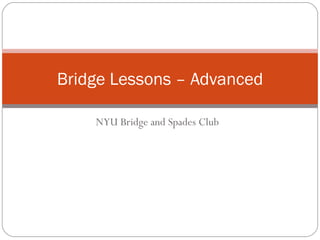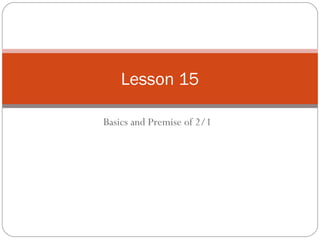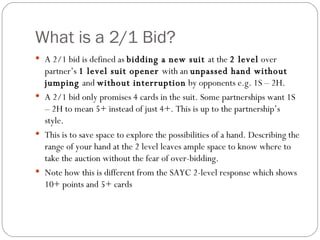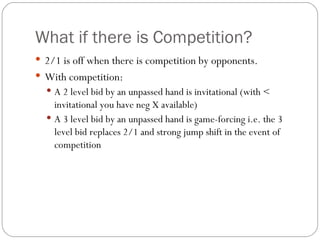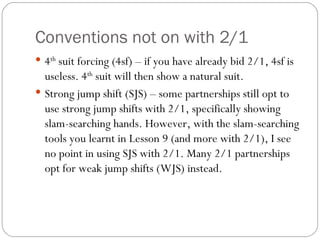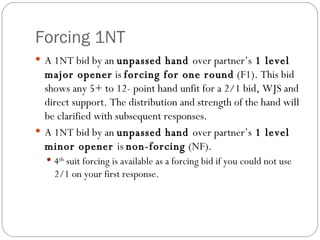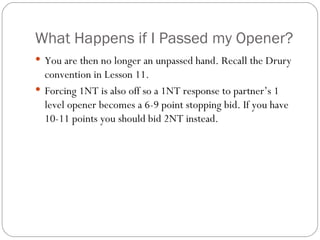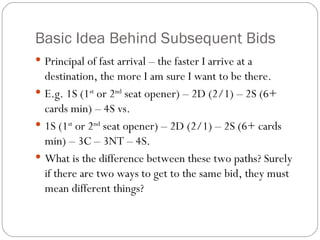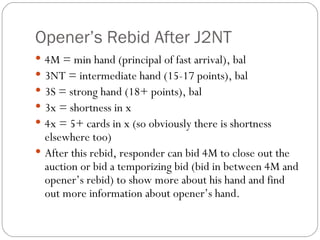Lesson 15 The Basics And The Premise Of 2 Over 1
- 1. NYU Bridge and Spades Club Bridge Lessons – Advanced
- 2. Basics and Premise of 2/1 Lesson 15
- 3. What is a 2/1 Bid? A 2/1 bid is defined as bidding a new suit at the 2 level over partner’s 1 level suit opener with an unpassed hand without jumping and without interruption by opponents e.g. 1S – 2H. A 2/1 bid only promises 4 cards in the suit. Some partnerships want 1S – 2H to mean 5+ instead of just 4+. This is up to the partnership’s style. This is to save space to explore the possibilities of a hand. Describing the range of your hand at the 2 level leaves ample space to know where to take the auction without the fear of over-bidding. Note how this is different from the SAYC 2-level response which shows 10+ points and 5+ cards
- 4. What if there is Competition? 2/1 is off when there is competition by opponents. With competition: A 2 level bid by an unpassed hand is invitational (with < invitational you have neg X available) A 3 level bid by an unpassed hand is game-forcing i.e. the 3 level bid replaces 2/1 and strong jump shift in the event of competition
- 5. Conventions not on with 2/1 4 th suit forcing (4sf) – if you have already bid 2/1, 4sf is useless. 4 th suit will then show a natural suit. Strong jump shift (SJS) – some partnerships still opt to use strong jump shifts with 2/1, specifically showing slam-searching hands. However, with the slam-searching tools you learnt in Lesson 9 (and more with 2/1), I see no point in using SJS with 2/1. Many 2/1 partnerships opt for weak jump shifts (WJS) instead.
- 6. Forcing 1NT A 1NT bid by an unpassed hand over partner’s 1 level major opener is forcing for one round (F1). This bid shows any 5+ to 12- point hand unfit for a 2/1 bid, WJS and direct support. The distribution and strength of the hand will be clarified with subsequent responses. A 1NT bid by an unpassed hand over partner’s 1 level minor opener is non-forcing (NF). 4 th suit forcing is available as a forcing bid if you could not use 2/1 on your first response.
- 7. What Happens if I Passed my Opener? You are then no longer an unpassed hand. Recall the Drury convention in Lesson 11. Forcing 1NT is also off so a 1NT response to partner’s 1 level opener becomes a 6-9 point stopping bid. If you have 10-11 points you should bid 2NT instead.
- 8. Basic Idea Behind Subsequent Bids Principal of fast arrival – the faster I arrive at a destination, the more I am sure I want to be there. E.g. 1S (1 st or 2 nd seat opener) – 2D (2/1) – 2S (6+ cards min) – 4S vs. 1S (1 st or 2 nd seat opener) – 2D (2/1) – 2S (6+ cards min) – 3C – 3NT – 4S. What is the difference between these two paths? Surely if there are two ways to get to the same bid, they must mean different things?
- 9. Principal of Fast Arrival In the second route, responder managed to show something extra – length in clubs. Also, one more hidden gem is the strong possibility of shortness in H (probably 5D, 4C, 3S, 1H). Furthermore, responder must have had a good reason not to bid 4S directly even with a good fit in S. Note he could not bid a splinter bid with only 3 trumps. Based on the principal of fast arrival, the first responder must have wanted to shut out further bidding – hey, we’ve found our optimal destination, stop bidding. Basically, the first responder saw opener’s min bid and decided there was definitely no slam. The second responder is probably holding an intermediate to strong hand. Unsure as to whether there is a slam available, he chose not to bid 4NT directly, instead showing indirectly what kind of hand he probably holds. The principal of fast arrival dictates the meaning of many rebids in the 2/1 system.
- 10. Jacoby 2NT (J2NT) I’ve mentioned this convention before but I cannot remember if it has been included in any lesson before (too lazy to check). Regardless, here is the convention: Partner opens 1M and you have good support in M. You are unsure as to whether you have a slam or just a game; you are unable to bid 4NT directly (for fear of 5M-1) and do not have shortness (so no splinter bid available). What now? A 2NT bid by an unpassed hand over partner’s 1M opener shows 4+ cards in M and 12+ points.
- 11. Opener’s Rebid After J2NT 4M = min hand (principal of fast arrival), bal 3NT = intermediate hand (15-17 points), bal 3S = strong hand (18+ points), bal 3x = shortness in x 4x = 5+ cards in x (so obviously there is shortness elsewhere too) After this rebid, responder can bid 4M to close out the auction or bid a temporizing bid (bid in between 4M and opener’s rebid) to show more about his hand and find out more information about opener’s hand.
- 12. Notes Regarding Jacoby 2NT (J2NT) This convention is especially useful with 2/1. Some SAYC users opt to use J2NT as well but I am not a huge fan of doing so. With SAYC, the availability of SJS makes Jacoby 2NT less useful. Also, removing the ability to show a 10-12 point hand can handicap many SAYC pairs. Not so with 2/1 WJS users. With forcing 1NT, there is no need for a separate bid to show specifically a 10-12 point hand. Reminder: J2NT only works over major openers. 2NT over a minor opener preserves its SAYC meaning (as does 1NT).

